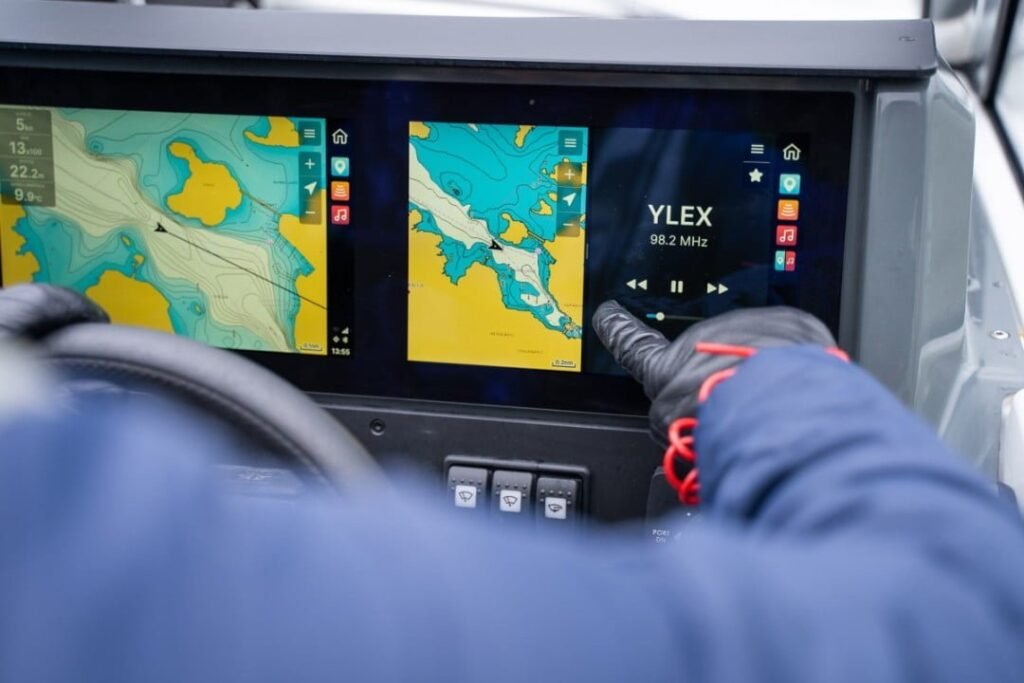What Defines an Industrial Touch Display?
An industrial touch display is specifically designed for rugged environments and mission-critical applications. These displays go beyond everyday usability and are tailored for industries such as:
- Manufacturing and factory automation
- Transportation and logistics
- Medical and healthcare equipment
- Marine and outdoor systems
- Military and defense applications
They are built to operate reliably in extreme temperatures, withstand mechanical stress, and resist dust, water, or chemicals—conditions where ordinary consumer displays would quickly fail.
Key Differences Between Industrial and Consumer Touch Displays
1. Durability and Lifespan
- Industrial displays: Designed for 24/7 operation, with lifespans of 50,000+ hours. They are tested to withstand vibration, shock, and long-term continuous use.
- Consumer displays: Optimized for daily lifestyle use, typically lasting 3–5 years before obsolescence. Frequent use in rugged environments often leads to premature failure.
2. Temperature Tolerance
- Industrial: Operates in -30°C to +85°C, ideal for cold storage facilities, outdoor kiosks, or industrial vehicles.
- Consumer: Typically limited to 0°C to +40°C, making them unsuitable for demanding conditions.
3. Environmental Resistance
- Industrial: Often IP-rated (IP65 or higher), offering protection against dust, water jets, or even immersion. Some models include anti-corrosion coatings.
- Consumer: Minimal protection—sensitive to humidity, spills, or exposure to outdoor sunlight.
4. Touch Technology
- Industrial: Supports projected capacitive (PCAP) と IPS タッチパネルでは、タッチ層は薄いガラスのオーバーレイとして見え、 with features like glove operation, water rejection, and multi-touch gestures.
- Consumer: Standard capacitive touch optimized for bare fingers, often failing in wet or glove-wearing conditions.
5. Brightness and Readability
- Industrial: High-brightness panels up to 1500 cd/m², with anti-glare or optical bonding for sunlight readability.
- Consumer: Typical brightness of 200–400 cd/m², sufficient for indoor use but difficult to see outdoors.
6. Interface and Compatibility
- Industrial: Flexible interfaces such as LVDS, HDMI, VGA, or RS-232, ensuring compatibility with legacy and modern systems.
- Consumer: Limited to mainstream interfaces like HDMI or USB, with little customization.
7. Longevity of Supply
- Industrial: Guaranteed long-term availability (5–10+ years), critical for product lifecycle management in medical or transportation systems.
- Consumer: Fast obsolescence cycles, with new models replacing old ones every 12–18 months.
8. Cost Considerations
- Industrial: Higher upfront cost but lower total cost of ownership due to reduced downtime and replacement needs.
- Consumer: Lower purchase cost, but frequent failures or redesigns often result in higher lifetime costs for businesses.
Why Industrial Displays Matter in Mission-Critical Applications
Imagine a medical ventilator display failing mid-surgery, or a factory automation panel freezing during production. The consequences could be severe, ranging from safety hazards to costly downtime.
This is why industries cannot rely on consumer-grade screens. Industrial displays ensure:
- Operational reliability in non-stop environments
- Enhanced user safety with fail-safe designs
- Regulatory compliance for medical and automotive standards
- Reduced maintenance costs due to rugged construction
In short, industrial touch displays are not just a component—they are a safeguard.
Choosing the Right Display: Factors to Consider
When selecting between industrial and consumer displays, decision-makers should evaluate:
- Application environment (temperature, dust, humidity, vibration)
- Expected product lifecycle (short-term vs. long-term deployment)
- Touch functionality (glove use, water rejection, multi-touch needs)
- Brightness requirements (indoor vs. outdoor readability)
- Budget vs. total cost of ownership
For example, while a consumer display might suffice for a point-of-sale kiosk inside a mall, an industrial-grade display is essential for an outdoor ticketing machine exposed to sun, rain, and snow.
Future Trends in Industrial Touch Displays
As technology evolves, industrial displays are moving beyond durability to offer smarter, more interactive features:
- Optical bonding for higher clarity and reduced reflection
- Integration with IoT platforms for real-time data monitoring
- AI-driven interfaces for predictive maintenance and adaptive user experiences
- Mini-LED and OLED options bringing better contrast and lower power consumption
- Enhanced cybersecurity layers to prevent unauthorized access in critical infrastructure
The future points toward displays that are not only rugged but also intelligent, playing a central role in Industry 4.0.
を要求すべきである
The difference between industrial touch displays と IPS consumer touch displays それは単なる耐久性以上のもの――すなわち、 目的適合性、安全性、そして長期的な性能にあります。民生用スクリーンが利便性と価格の手頃さを追求する一方で、産業用ディスプレイは、 ミッションクリティカルな環境において一切の妥協なき信頼性を提供するために構築されています。.
医療、産業、運輸、または防衛分野で 機器の開発を行う企業にとって、選択は明白です:産業グレードのタッチディスプレイへの投資は、単なる技術の問題ではなく―― 信頼、安全性、そしてビジネス継続性を保証するためのものです。.

